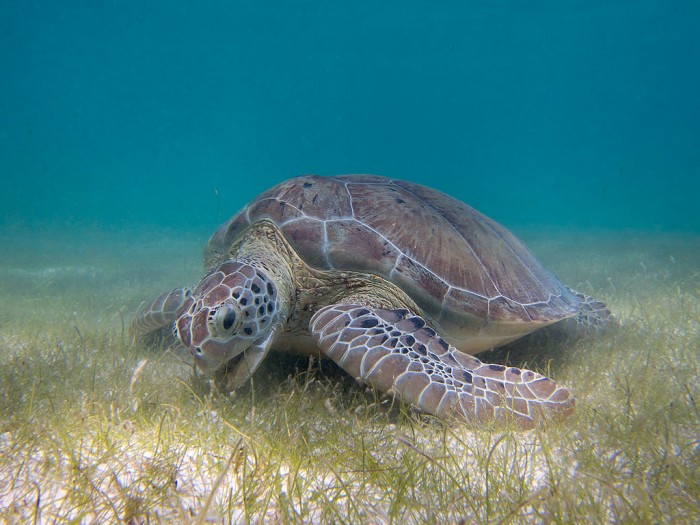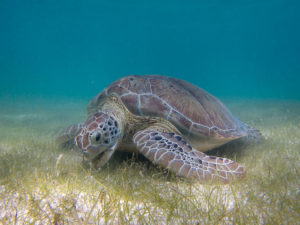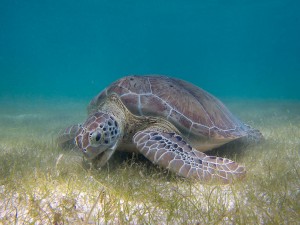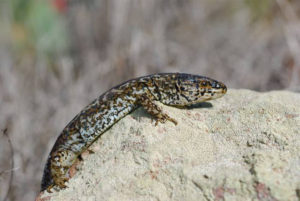Climate Change and Sea Turtles
The warming of the planet due to climate change is causing reproduction patterns to change.
 Image: By P.Lindgren (Own work) [CC BY-SA 3.0 (http://creativecommons.org/licenses/by-sa/3.0)], via Wikimedia Commons
Image: By P.Lindgren (Own work) [CC BY-SA 3.0 (http://creativecommons.org/licenses/by-sa/3.0)], via Wikimedia Commons Climate change will have a massive impact on many species, but sea turtles will particularly affected. They are born without an X or Y chromosome, so the gender of sea turtles while still in the egg is determined by the incubation temperature – warmer conditions produce females and cooler conditions produce males. Therefore, the warming of the planet due to climate change is causing their reproduction patterns to change.
Marine turtles deposit their eggs in underground nests where they develop unattended and without parental care. The incubation temperature varies with different environmental conditions, including rainfall, sun, shade and sand type. These all affect developmental rates, and hatch and emergence success, as well as gender. New research published in Endangered Species Research has discovered that drought, heavy rainfall and changes to the climate are all impacting hatchling sex ratios and influencing future reproduction.
The four-year study was conducted by scientists from the Florida Atlantic University, who examined the relationship between rainfall and sand temperature, as well as rainfall, nest temperatures and hatchling sex ratios at a loggerhead turtle nesting beach in Boca Raton, southeast Florida. “The shift in our climate is shifting turtles as well, because as the temperature of their nests change so do their reproduction patterns,” said Jeanette Wyneken, professor of biological sciences in FAU’s Charles E. Schmidt College of Science. “The nesting beaches along Florida’s coast are important, because they produce the majority of the loggerhead hatchlings entering the northwestern Atlantic Ocean.”
Her team sampled nests during the nesting seasons (April to October) between 2010 and 2013. They used temperature dataloggers in the sand at three locations and buried them at three different depths to create temperature profiles of the sand column above the nests. Corresponding rainfall data for each level was also recorded, and data was collected throughout the incubation period. They discovered that light rainfall affected only the surface sand, but the heaviest rainfall did lower sand temperatures. The sex of newly hatched turtles was verified laparoscopically to provide sex ratio – this revealed that the majority of turtles they sampled were female, suggesting that across the four seasons, nest temperatures were not sufficiently cool to produce males.
Only one in 2,500-7,000 sea turtles make it to adulthood. The typical female loggerhead turtle produces about 105 eggs per nesting season and would have to nest for more than 10 nesting seasons over the span of 20 to 30 years just to replace herself and possibly one mate. If enough males aren’t being produced because of climate change, then the species will be in trouble. “If climatic changes continue to force the sex ratio bias of loggerheads to even greater extremes, we are going to lose the diversity of sea turtles as well as their overall ability to reproduce effectively. Sex ratios are already strongly female biased,” said Wyneken. “That’s why it’s critical to understand how environmental factors, specifically temperature and rainfall, influence hatchling sex ratios.”
Another university in Florida – the University of Central Florida – also raised concerns for sea turtles in the state earlier this year, with research published in Chelonian Conservation and Biology. This study warns that over 30 years of conservation efforts to protect sea turtles may be at risk due to climate change. It also states that the way in which coastal communities react to sea level rise, caused by climate change, could have serious and potentially dire consequences for sea turtles and any other wildlife that rely on unobstructed beaches for survival.
Studies have been conducted for over 30 years in the Archie Carr National Wildlife Refuge – a 13-mile stretch of beach that is one of the most important nesting habitats for green and loggerhead turtles in the western hemisphere. Sea turtles have not always thrived in the refuge. In 1982, green turtles numbered in the 30s and loggerhead turtles numbered around 9,000 in the 1980s. Since the refuge was created in 1991, giving the turtles a protected place to lay their eggs, green turtles now number more than 12,000 and loggerhead turtles now number over 15,000.
The number of turtles laying eggs, the number of eggs that hatch and how many young turtles make it to the water have been studied in this area, but scientists have also examined how sea level has risen over the same timeframe. Sea level rise and an increase in storm intensity could potentially impact the refuge in “fundamental ways” including beach erosion and a narrowing of the beach. At present, egg and nest loss to erosion is the factor that has the greatest negative impact on the emerging success of hatchlings. Sea level has risen by about 5.75 inches in 112 years, and continues to rise at a more rapid pace. This means that the erosion of beaches will also continue more rapidly.
To guard against erosion, beach communities may start armouring – putting up hard surfaces to protect the beach. This would be disastrous for wildlife as it puts up barriers, and would impact the sea turtles’ ability to nest. The beaches must be allowed to move.
The authors warn against armouring the private and commercial properties in the refuge. “The crux of the matter is that sea-level rise is happening, there’s no question,” said Llewellyn Ehrhart, lead author of the study. “Our response has to be an intelligent one. We can’t continue to build hard structures because it is only going to make matters worse for sea turtles and the beach in general. We need courageous leadership to find good solutions, not just easy ones.”





No comments yet.